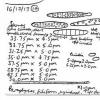
24-12-2025 17:08
Hulda Caroline HolteHello, I have found this propoloid ascomycete on

21-12-2025 09:32
Hello.A tiny ascomycete found embedded in wood in

21-12-2025 21:32
Pol DebaenstHello, Garden, Burgweg 19, Veurne, BelgiumOn 10/1

22-12-2025 23:38
Patrice TANCHAUDBonsoir, récolte sur un mur en pierre, apothéci

22-12-2025 00:47
Patrice TANCHAUDBonsoir, récolte à proximité du milieu dunaire
Patellaria or Lecanidion
Peter Thompson,
19-12-2013 15:26
I have been considering an ascomycete which seems to be growing in association with a lichen or alga. There is a slimy, green film on the wood, which is decorticated Betula pendula.
In many ways, it seems to fit best with the genus Patellaria (long, multiply septate spores, asci which rupture at the tip, no reaction to lugol and parallel, regularly septate hyphae in the excipulum).
There seem to be inconsistencies as well (olive green hymenium and paraphyses neither branched nor swollen at the tips).
I have attached a photograph of the fruit bodies and a sketch of the microscopy and wonder if anyone has an idea as to what it is.
Thank you,
Peter.
Gernot Friebes,
19-12-2013 15:33
Re : Patellaria or Lecanidion
Hi Peter,
how about Durella connivens?
Best wishes,
Gernot
how about Durella connivens?
Best wishes,
Gernot
Peter Thompson,
19-12-2013 18:06
Re : Patellaria or Lecanidion
Hello Gernot,
Thank you for your reply.
I overlooked Durella. It seems that D. connivens can have olive green hymenium as well as grey hymenium.
The green algal sliminess on the host and the 7-septate spores also fit. I was surprised to see that all of the spores with septa had exactly seven.
I think that you are right.
With Best Wishes,
Peter.
Thank you for your reply.
I overlooked Durella. It seems that D. connivens can have olive green hymenium as well as grey hymenium.
The green algal sliminess on the host and the 7-septate spores also fit. I was surprised to see that all of the spores with septa had exactly seven.
I think that you are right.
With Best Wishes,
Peter.

